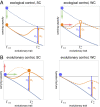Eco-evolutionary control of pathogens
- PMID: 32737164
- PMCID: PMC7443876
- DOI: 10.1073/pnas.1920263117
Eco-evolutionary control of pathogens
Abstract
Control can alter the eco-evolutionary dynamics of a target pathogen in two ways, by changing its population size and by directed evolution of new functions. Here, we develop a payoff model of eco-evolutionary control based on strategies of evolution, regulation, and computational forecasting. We apply this model to pathogen control by molecular antibody-antigen binding with a tunable dosage of antibodies. By analytical solution, we obtain optimal dosage protocols and establish a phase diagram with an error threshold delineating parameter regimes of successful and compromised control. The solution identifies few independently measurable fitness parameters that predict the outcome of control. Our analysis shows how optimal control strategies depend on mutation rate and population size of the pathogen, and how monitoring and computational forecasting affect protocols and efficiency of control. We argue that these results carry over to more general systems and are elements of an emerging eco-evolutionary control theory.
Keywords: biophysics; control theory; immune systems; population genetics.
Copyright © 2020 the Author(s). Published by PNAS.
Conflict of interest statement
The authors declare no competing interest.
Figures




References
Publication types
MeSH terms
Substances
LinkOut - more resources
Full Text Sources

